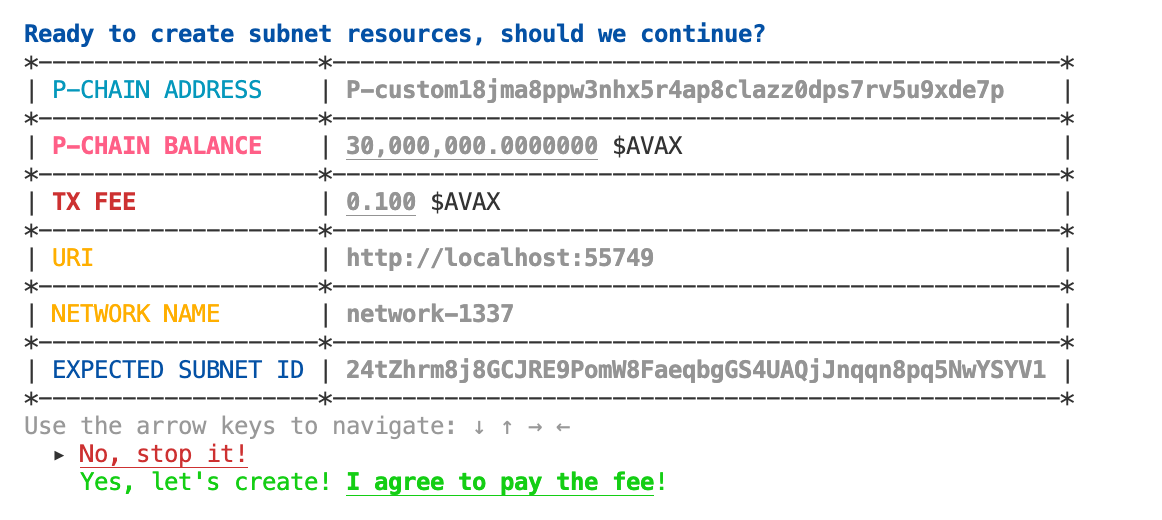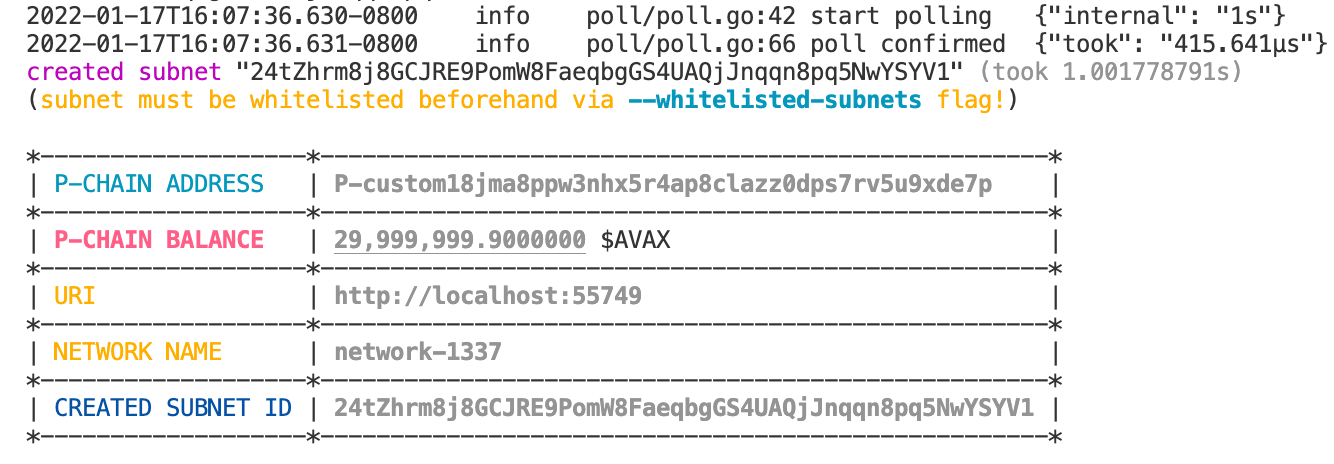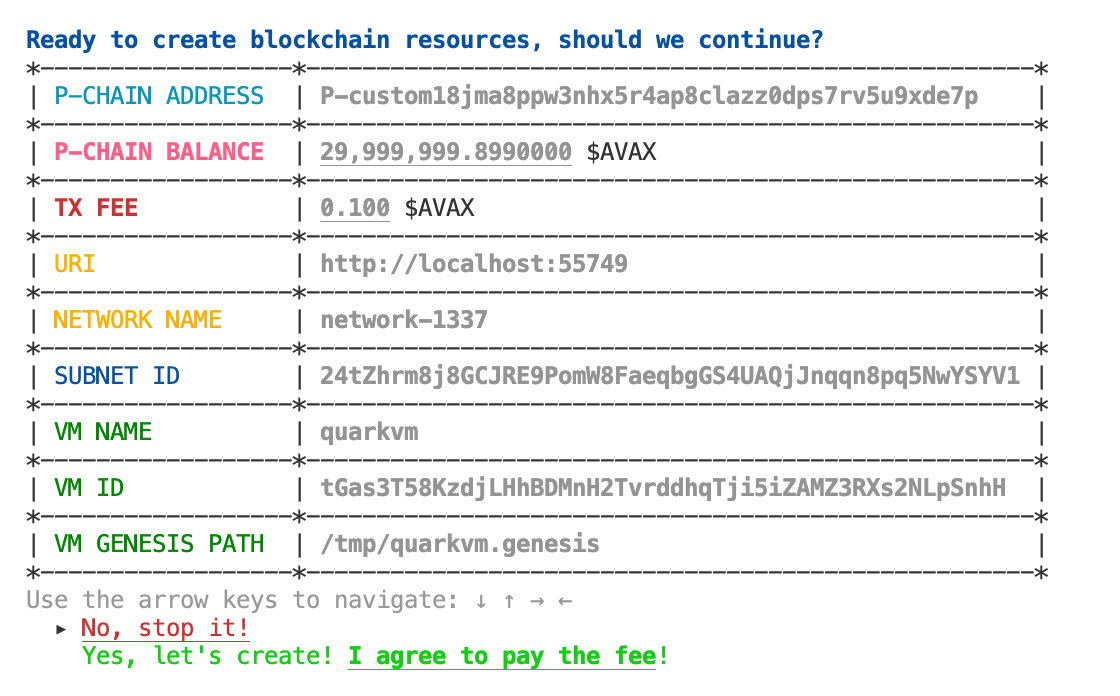A command-line interface to manage Avalanche Subnets.
git clone https://github.com/ava-labs/subnet-cli.git;
cd subnet-cli;
go install -v .;Once you have installed subnet-cli, check the help page to confirm it is
working as expected (make sure your $GOBIN is in your $PATH):
subnet-cli CLI
Usage:
subnet-cli [command]
Available Commands:
add Sub-commands for creating resources
completion Generate the autocompletion script for the specified shell
create Sub-commands for creating resources
help Help about any command
status status commands
Flags:
--enable-prompt 'true' to enable prompt mode (default true)
-h, --help help for subnet-cli
--log-level string log level (default "info")
--poll-interval duration interval to poll tx/blockchain status (default 1s)
--request-timeout duration request timeout (default 2m0s)
Use "subnet-cli [command] --help" for more information about a command.The following commands will walk you through creating a subnet on Fuji.
This command is used to generate a valid VMID based on some string to uniquely identify a VM. This should stay the same for all versions of the VM, so it should be based on a word rather than the hash of some code.
subnet-cli create VMID <identifier> [--hash]subnet-cli create keysubnet-cli will assume you have funds on this key (or --private-key-path) on the P-Chain for the
rest of this walkthrough.
The easiest way to do this (for testing only) is:
- Import your private key (
.subnet-cli.pk) into the web wallet - Request funds from the faucet
- Move the test funds (sent on either the X or C-Chain) to the P-Chain (Tutorial)
After following these 3 steps, your test key should now have a balance on the P-Chain.
subnet-cli create subnetTo create a subnet in the local network:
subnet-cli create subnet \
--private-key-path=.insecure.ewoq.key \
--public-uri=http://localhost:55749subnet-cli add validator \
--node-id="[YOUR-NODE-ID]" \
--subnet-id="[YOUR-SUBNET-ID]"To add a validator with the local network:
subnet-cli add validator \
--private-key-path=.insecure.ewoq.key \
--public-uri=http://localhost:55749 \
--node-id="NodeID-7Xhw2mDxuDS44j42TCB6U5579esbSt3Lg" \
--subnet-id="24tZhrm8j8GCJRE9PomW8FaeqbgGS4UAQjJnqqn8pq5NwYSYV1"subnet-cli create blockchain \
--subnet-id="[YOUR-SUBNET-ID]" \
--chain-name="[YOUR-CHAIN-NAME]" \
--vm-id="[YOUR-VM-ID]" \
--vm-genesis-path="[YOUR-VM-GENESIS-PATH]"To create a blockchain with the local cluster:
subnet-cli create blockchain \
--private-key-path=.insecure.ewoq.key \
--public-uri=http://localhost:55749 \
--subnet-id="24tZhrm8j8GCJRE9PomW8FaeqbgGS4UAQjJnqqn8pq5NwYSYV1" \
--chain-name=test \
--vm-id=tGas3T58KzdjLHhBDMnH2TvrddhqTji5iZAMZ3RXs2NLpSnhH \
--vm-genesis-path=/tmp/testvm.genesisTo check the status of the blockchain 2o5THyMs4kVfC42yAiSt2SrjWNkxCLYZef1kewkqYPEiBPjKtn from the private URI:
subnet-cli status blockchain \
--private-uri=http://localhost:55749 \
--blockchain-id="2o5THyMs4kVfC42yAiSt2SrjWNkxCLYZef1kewkqYPEiBPjKtn" \
--check-bootstrappedSee scripts/tests.e2e.sh and tests/e2e/e2e_test.go for example tests.
# [OPTIONAL]
# build avalanchego for local testing
cd ${HOME}/go/src/github.com/ava-labs/avalanchego
rm -rf ./build
./scripts/build.sh
# [OPTIONAL]
# build test runner for local cluster setup
cd ${HOME}/go/src/github.com/ava-labs/subnet-cli/tests/runner
go build -o /tmp/subnet-cli.runner -v .
/tmp/subnet-cli.runner \
--avalanchego-path ${HOME}/go/src/github.com/ava-labs/avalanchego/build/avalanchego \
--whitelisted-subnets="24tZhrm8j8GCJRE9PomW8FaeqbgGS4UAQjJnqqn8pq5NwYSYV1" \
--output-path /tmp/subnet-cli.runner.yml
# [OPTIONAL]
# get cluster endpoints to send requests to
cat /tmp/subnet-cli.runner.ymluris:
- http://localhost:57574
...




